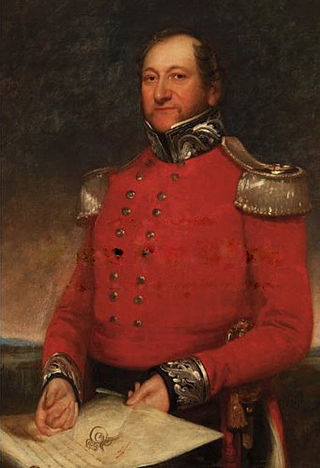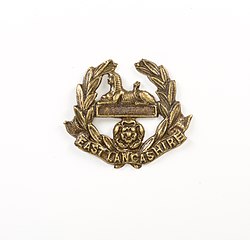The Lancashire Militia was an auxiliary military force in Lancashire in North West England. From their formal organisation as Trained Bands in 1558 and their service in the Williamite War in Ireland and against the Jacobite Risings, the Militia regiments of Lancashire served during times of international tension and all of Britain's major wars. They provided internal security and home defence but sometimes operated further afield, including Ireland and the Mediterranean, relieving regular troops from routine garrison duties, and acting as a source of trained officers and men for the Regular Army. All the infantry battalions went on active service during the Second Boer War and all served as Special Reserve training units in World War I, with one battalion seeing considerable action on the Western Front. After 1921 the militia had only a shadowy existence until its final abolition in 1953.
The Royal Sussex Light Infantry Militia, later the 3rd Battalion, Royal Sussex Regiment, was an auxiliary regiment raised in Sussex on the South Coast of England. From its formal creation in 1778 the regiment served in home defence in all of Britain's major wars. It saw active service during the Second Boer War, and trained thousands of reinforcements during World War I. After a shadowy postwar existence it was formally disbanded in 1953
The Royal East Middlesex Militia was an auxiliary regiment reorganised in Middlesex in the Home counties of England during the 18th Century from earlier precursor units. It later became part of the Middlesex Regiment. Primarily intended for home defence, it saw action in the Second Boer War. It was converted to the Special Reserve under the Haldane Reforms and supplied reinforcements to the Middlesex Regiment's fighting battalions during World War I. After a shadowy postwar existence the unit was finally disbanded in 1953.
The East York Militia was a part time home defence force in the East Riding of Yorkshire. The Militia and its predecessors had always been important in Yorkshire, and from its formal creation in 1759 the regiment served in home defence in all Britain's major wars until 1919. It became a battalion of the East Yorkshire Regiment, and its role during World War I was to train thousands of reinforcements for the regiment's battalions serving overseas.
The 3rd Royal Lancashire Militia (The Duke of Lancaster's Own) was an auxiliary regiment raised in the county of Lancashire in North West England during the French Revolutionary War. It later became part of the Loyal North Lancashire Regiment. Although primarily intended for home defence, its battalions served in Ireland, Gibraltar and Malta and saw active service during the Second Boer War. After conversion to the Special Reserve (SR) under the Haldane Reforms it supplied reinforcements to the fighting battalions during World War I. After a shadowy postwar existence the unit was finally disbanded in 1953.
The 4th Royal Lancashire Militia (The Duke of Lancaster's Own Light Infantry) was an auxiliary regiment raised in the county of Lancashire in North West England just before the Crimean War. It later became part of the South Lancashire Regiment. Although primarily intended for home defence, it saw considerable active service during the Second Boer War. After conversion to the Special Reserve (SR) under the Haldane Reforms it supplied reinforcements to the fighting battalions during World War I and carried out internal security duties in Ireland. After a shadowy postwar existence the unit was finally disbanded in 1953.
The 6th Royal Lancashire Militia was an auxiliary regiment raised in the county of Lancashire in North West England just before the Crimean War. It later became part of the Manchester Regiment. Although primarily intended for home defence, its battalions saw active service during the Second Boer War. Following conversion to the Special Reserve (SR) under the Haldane Reforms it supplied reinforcements to the fighting battalions during World War I. After a shadowy postwar existence the unit was finally disbanded in 1953.
The 1st Royal Lancashire Militia (The Duke of Lancaster's Own) was an auxiliary regiment raised in the county of Lancashire in North West England during the 17th Century. Primarily intended for home defence, it saw active service in Ireland under King William III, as well as against the Jacobite Risings of 1715 and 1745. It spent long periods on defence duties during the wars of the 18th Century and early 19th Century, and was stationed on the Ionian Islands during the Crimean War. It later became part of the King's Own (Royal Lancaster Regiment) and saw active service in the Second Boer War. After its conversion to the Special Reserve under the Haldane Reforms, it supplied reinforcements to the fighting battalions during World War I. After a shadowy postwar existence the unit was finally disbanded in 1953.
The 2nd Royal Lancashire Militia (The Duke of Lancaster's Own Rifles) was an auxiliary regiment raised in the county of Lancashire in North West England during the French Revolutionary War. It later became part of the King's (Liverpool Regiment). Although primarily intended for home defence, its battalions served in Ireland and saw active service during the Second Boer War. After conversion to the Special Reserve (SR) under the Haldane Reforms one of its battalions was among just a handful of SR units to see combat during World War I, fighting in many actions on the Western Front from early 1915 until the Armistice in 1918. After a shadowy postwar existence the unit was finally disbanded in 1953.

The Surrey Militia was an auxiliary military force in Surrey, England. From their formal organisation as trained bands in 1558 until their final service as the Special Reserve, the Militia regiments of the county served in home defence in all of Britain's major wars. They also saw active service during the Second Boer War, and trained thousands of reinforcements during World War I. After a shadowy postwar existence they were formally disbanded in 1953.
The 1st Royal Surrey Militia, later the 3rd Battalion, East Surrey Regiment was an auxiliary regiment raised in Surrey in the Home Counties of England. From its formal creation in 1759 the regiment served in home defence in all of Britain's major wars until 1918, seeing active service in the Second Boer War and supplying reinforcements to the East Surreys during World War I.
The 2nd Royal Surrey Militia, later the 3rd Battalion, Queen's was an auxiliary regiment raised in Surrey in the Home counties of England. From its formal creation in 1797 the regiment served in home defence in all of Britain's major wars. It saw active service during the Second Boer War, including the Defence of Okiep, and trained thousands of reinforcements during World War I. After a shadowy postwar existence it was formally disbanded in 1953
The 3rd Royal Surrey Militia, later the 4th Battalion, East Surrey Regiment was an auxiliary regiment raised 1853 in Surrey in the Home counties of England. The regiment's role was to serve in home defence, but it saw active service during the Second Boer War, and trained thousands of reinforcements during World War I, one of its new officers winning a Victoria Cross. After a shadowy postwar existence the battalion was formally disbanded in 1953.
The 7th Royal Lancashire Militia (Rifles) (7th RLM) was an auxiliary regiment raised in the county of Lancashire in North West England just before the Crimean War. It later became part of the Lancashire Fusiliers. Although primarily intended for home defence, its battalions saw active service during the Second Boer War. Following conversion to the Special Reserve (SR) under the Haldane Reforms it supplied reinforcements to the fighting battalions during World War I. After a shadowy postwar existence the unit was finally disbanded in 1953.
The King's Own Light Infantry Militia, later the 3rd Battalion, North Staffordshire Regiment was an auxiliary regiment raised in Staffordshire in the West Midlands of England in 1853. Under the Cardwell and Childers Reforms it became part of the North Staffordshire Regiment and saw active service during the Second Boer War. During World War I it trained thousands of reinforcements for the battalions serving overseas. After a shadowy postwar existence it was formally disbanded in 1953.
The Royal Westminster Militia, later the 5th (Reserve) Battalion, Royal Fusiliers, was an auxiliary regiment raised in the City of Westminster in the suburbs of London. Descended from the Westminster Trained Bands, which were on duty during the Armada campaign of 1588 and saw considerable service during the English Civil War, the regiment underwent reorganisation in 1760 as part of the Middlesex Militia. From 1778 until 1918 the regiment served in home and colonial defence in all of Britain's major wars, and supplied thousands of reinforcements to the Royal Fusiliers during World War I. After a shadowy postwar existence the unit was finally disbanded in 1953.
The 4th Middlesex or Royal South Middlesex Militia was an auxiliary regiment raised in Middlesex in the Home counties of England just before the Crimean War. It later became part of the Royal Fusiliers. Primarily intended for home defence, it served in England and Ireland during Britain's major wars. It was converted to the Special Reserve under the Haldane Reforms and supplied reinforcements to the Royal Fusiliers' fighting battalions during World War I. After a shadowy postwar existence the unit was finally disbanded in 1953.
The 5th Middlesex Militia or Royal Elthorne Light Infantry was an auxiliary regiment raised in Middlesex in the Home counties of England just before the Crimean War. It later became part of the Middlesex Regiment. Primarily intended for home defence, it served in England and Ireland during Britain's major wars, and saw active service during the Second Boer War. It was converted to the Special Reserve under the Haldane Reforms and supplied reinforcements to the Royal Fusiliers' fighting battalions during World War I. After a shadowy postwar existence the unit was finally disbanded in 1953.
The Glamorganshire Militia, later the Royal Glamorgan Light Infantry, was an auxiliary regiment reorganised in the county of Glamorganshire in South Wales during the 18th Century from earlier precursor units. Primarily intended for home defence, it served in Britain and Ireland through all Britain's major wars and supported the civil powers in peacetime. It became a battalion of the Welsh Regiment in 1881, and saw active service in the Second Boer War. Transferring to the Special Reserve in 1908 it trained thousands of reinforcements for that regiment during World War I. After a shadowy postwar existence, the militia was disbanded in 1953.

The 2nd Somerset Militia was an auxiliary military regiment in the county of Somerset in South West England. First organised during the Seven Years' War it was reformed at the start of the French Revolutionary War and continued on internal security and home defence duties in all of Britain's major wars. It later became a battalion of the Somerset Light Infantry and served in South Africa during the Second Boer War, but was disbanded in 1908.



